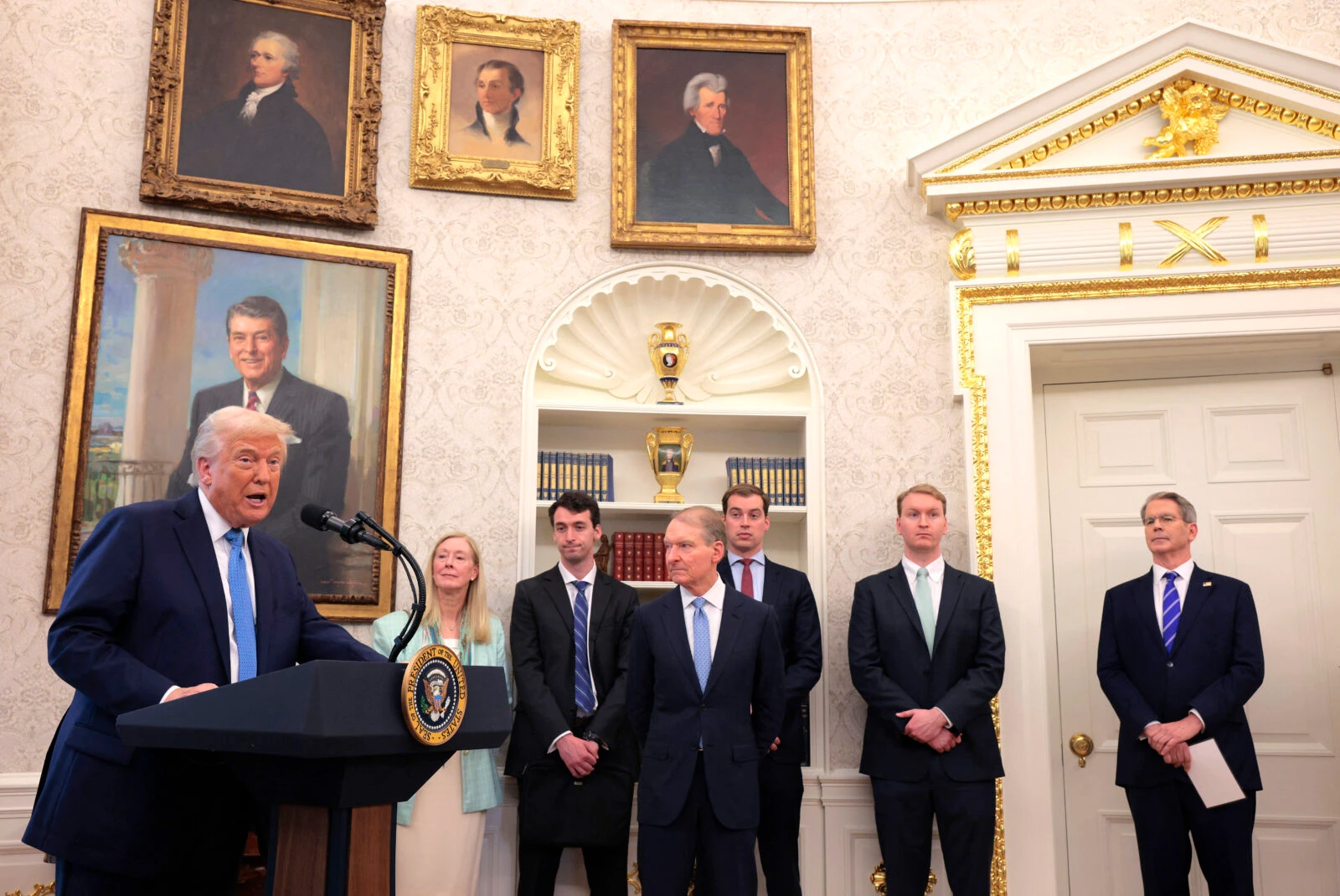Global markets rally on Trump’s hints of de-escalation, gold sheds recent gains
 Newspaper clippings and an image of U.S. President Donald Trump are displayed on a desk as traders work on the floor of the New York Stock Exchange (NYSE) at the opening bell in New York City, on April 21, 2025. (AFP Photo)
Newspaper clippings and an image of U.S. President Donald Trump are displayed on a desk as traders work on the floor of the New York Stock Exchange (NYSE) at the opening bell in New York City, on April 21, 2025. (AFP Photo)
U.S. President Donald Trump said on Tuesday he had no intention of removing Federal Reserve Chair Jerome Powell and indicated that tariffs on Chinese goods would be “substantially” reduced—offering relief to global markets rattled by his administration’s aggressive trade stance.
Concerns had mounted in recent days following Trump’s harsh criticism of Powell, which had sparked fears that the president might attempt to remove the central bank chief. The anxiety stemmed from Powell’s warnings that the White House’s expansive tariff policies could stoke inflationary pressures.
“I have no intention of firing him,” Trump stated on Tuesday. “I’d like to see him more proactive in his thinking on lowering interest rates—now is a perfect time for that. But if he doesn’t, is it the end? No.”
The remarks boosted investor sentiment, leading to a broad rally across equity markets. All three major U.S. stock indices advanced by approximately 2.6%, led by the tech-heavy Nasdaq, which rose 2.7%. Asian markets followed suit on Wednesday, with Japan’s Nikkei 225 and Hong Kong’s Hang Seng each climbing 1.7%, while Taiwan’s TAIEX surged over 3%.
European markets followed the upward trend, with Germany’s DAX rising over 2.3%, France’s CAC 40 gaining 1.95%, and the UK’s FTSE 100 up 1.3%.
Gold, which had spiked to a record high above $3,500 per ounce on Tuesday amid risk aversion, pulled back to around $3,315 by 6 a.m. GMT on Wednesday. Meanwhile, the U.S. dollar recovered modestly against major currencies, with the euro falling to 1.13 from 1.15 and the Japanese yen weakening to 0.0070.

Bitcoin, the world’s largest cryptocurrency, surged nearly 6%, climbing back above the $93,000 mark. The overall cryptocurrency market capitalization also rose by more than 6%, reaching approximately $2.93 trillion.

Oil prices advanced as well, with WTI crude futures rising around 3% to $64.32 per barrel, while Brent crude gained 2.7% to settle at $68.1.
Trump signals lower tariffs on China
Since returning to office in January, Trump’s administration has imposed additional tariffs of 145% on a wide range of Chinese products. The measures were initially justified by alleged Chinese involvement in the fentanyl supply chain and later expanded to address broader concerns over unfair trade practices.
China responded with retaliatory tariffs of 125% on American goods. However, Trump conceded on Tuesday that the 145% tariff level was “very high” and said it would be “coming down substantially.”
“They won’t be anywhere near that number,” he said. “But it won’t be zero either.”
“Ultimately, they have to make a deal, because otherwise they won’t be able to do business in the United States,” Trump added.

His remarks came after Treasury Secretary Scott Bessent said at a closed-door event in Washington that a de-escalation in U.S.-China trade tensions was expected soon, describing the current tariff levels as unsustainable.
Also on Tuesday, White House Press Secretary Karoline Leavitt revealed that the administration had received 18 formal trade proposals from foreign governments. “There is a lot of progress being made,” Leavitt told reporters, noting that the proposals had been submitted to the administration’s trade team. She added that senior officials—including Treasury Secretary Bessent and Commerce Secretary Howard Lutnick—are scheduled to meet with representatives from 34 countries this week.
As part of ongoing negotiations, the Trump administration has granted dozens of countries a 90-day exemption from tariffs above the 10% baseline. Officials aim to conclude as many as 90 separate trade agreements within that window.
Leavitt also expressed optimism about progress with Beijing. “The president and the administration are laying the groundwork for a deal,” she said, while noting that China had not yet confirmed participation in formal talks.
IMF cuts US growth outlook, flags increased recession risk
Meanwhile, the International Monetary Fund (IMF) lowered its U.S. growth forecast while cautioning that the likelihood of a recession has increased, though it remains unlikely as a base scenario.
Speaking during a press conference to present the IMF’s latest World Economic Outlook report, Chief Economist and Research Director Pierre-Olivier Gourinchas stated that the global economy is entering a new era, marked by unprecedented tariff levels in the United States.

Gourinchas said that the IMF projected the U.S. economy to expand by 1.8% in 2025, down from the previous forecast of 2.7% issued in January. Although this represents a notable slowdown, he emphasized it does not signify a recession. He also noted that the U.S. labor market remains robust despite signs of broader deceleration.
According to the report, the IMF now places the probability of a U.S. recession at around 40%, up from 25% in October.
On a global scale, the IMF revised its growth forecasts downward, citing heightened trade tensions and policy uncertainty. Global growth is now projected at 2.8% for 2025 and 3.0% for 2026, compared to the earlier forecast of 3.3% for both years.



